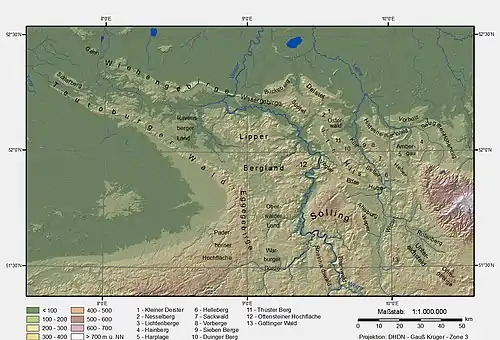Lower Saxon Hills
The Lower Saxon Hills[1] (German: Niedersächsisches Bergland) are one of the 73 natural regions in Germany defined by the Federal Agency for Nature Conservation (BfN). Geographically it covers roughly the same area as the Weser Uplands (German: Weserbergland) in its wider sense.[2]
The region is part of Germany's Central Uplands with hills ranging up to 528 m above sea level (NN) in height that extend across northeast North Rhine-Westphalia, southern Lower Saxony and northern Hesse. It is classified as region number D 36 by the BfN; its full name being the Niedersächsisches Bergland (mit Weser- und Leine-Bergland (Lower Saxon Hills, including the Weser and Leine Hills).
D 36 is a newly defined region that incorporates 3 geographical units from the old system: numbers 36, 37 and 53, and includes all parts of the Weser Uplands (Weserbergland) in both its narrower and a wider sense. That said, all three elements of the region, despite their misleading names, cover far more than is generally meant in everyday language or in atlases by the term Weserbergland.
In addition the Weser-Leine Hills sub-division (37) includes the whole of the Leine Uplands (Leinebergland), whilst the Harz mountains, admittedly are only partly in Lower Saxony, are clearly older in geological time scale and have been given their own natural region (D37) rather than being grouped with the lower Saxon Hills.

Natural divisions
The following tables show the landscape sub-divisions in the Lower Saxon Hills.
Those regions which are normally considered part of the Weser Uplands in its narrower sense are indicated by (W); similarly the which are normally included in the Leine Uplands are annotated with (L):
In addition to the Osning (=Teutoburg Forest) and the Wiehen Hills, historic landscapes like the Tecklenburger Land und Osnabrücker Land are also part of this region. |
The Weser Valley between Bad Karlshafen and Porta Westfalica also belongs to this area. |
- 37 Weser-Leine Uplands
|
|
References
- Elkins, T.H. (1972). Germany (3rd ed.). London: Chatto & Windus. ASIN B0011Z9KJA. ISBN 0-7010-0087-2.
- However at least one source, Elkins (1968), uses the term to refer to the outcrops of rock to the north, west and southwest of the Harz which roughly corresponds to the eastern half of the BfN's region and extends only as far as the area between the rivers Weser and Leine.
Literature
- Elkins, T.H. (1972). Germany (3rd ed.). London: Chatto & Windus. ASIN B0011Z9KJA. ISBN 0-7010-0087-2.
- Brunotte, Ernst; Garleff, Karsten (1989). "Structural landforms and planation surfaces in southern Lower Saxony". In Frank Ahnert (ed.). Landforms and Landform evolution in West Germany. Catena Supplement (15). Brunswick. pp. 151–161.